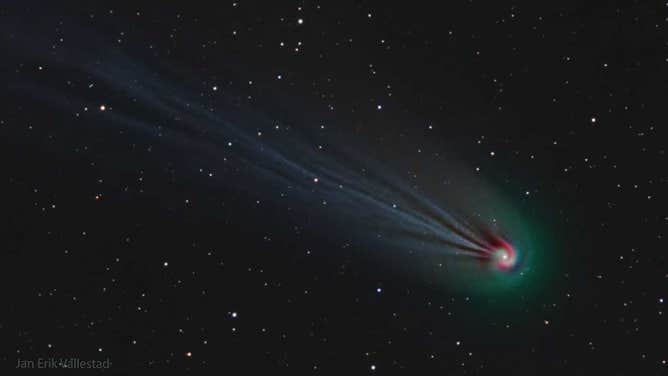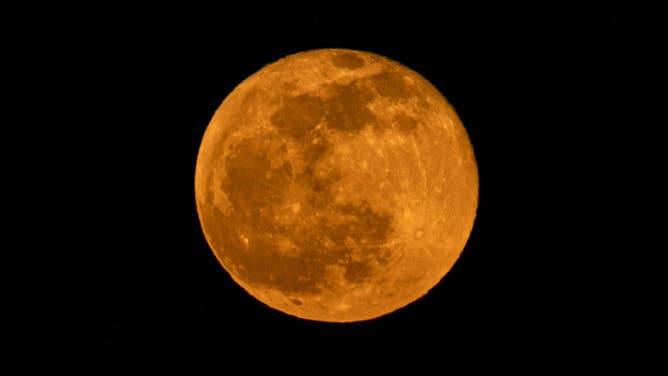April also features other astronomical events besides the total solar eclipse
The total solar eclipse on April 8th is the actual star this month but here are some non eclipse and eclipse adjacent astronomical events to look up for throughout April.
'Devil' Comet 12p approaches Sun in time for total solar eclipse
Comet 12P/Pons-Brooks also known as the "devil comet" is zooming toward its closest approach to the Sun, known as perihelion. Astronomers are tracking the comet in the night sky and its colorful reactions.
Without including the anticipated total solar eclipse, April is already packed with astronomical events to enjoy outside if the skies are clear, including the full Pink Moon and Comet 12P.
Here are some non-eclipse and eclipse-adjacent astronomy events worth looking up this month.
Comet 12P puts on a colorful show
Comet 12P/Pons-Brooks is zooming toward its closest approach to the Sun, known as perihelion. The comet is expected to be nearest the Sun in its 71-year orbit by the third week in April.
TOTAL SOLAR ECLIPSE FORECAST SHOWS WHO HAS BEST CHANCE FOR CLEAR SKIES ON APRIL 8TH
Comets are frozen leftovers from the formation of our solar system about 4.6 billion years ago, made up of dust, rocks and ice. As comets approach the Sun, they heat up and create a glowing atmosphere, or coma, and form the famous bright comet's tail, that can stretch for millions of miles, according to NASA.

The featured image is a composite of three very specific colors, showing the comet's ever-changing ion tail in light blue, its outer coma in green, and highlights some red-glowing gas around the coma in a spiral. The spiral is thought to be caused by gas being expelled by the slowly rotating nucleus of the giant iceberg comet. (Image Credit & Copyright: Jan Erik Vallestad )
(Jan Erik Vallestad)
Comet 12P is expected to become visible to the naked eye in early April. NASA said Comet 12P will be only 25 degrees away from the Sun during totality on April 8th.
By April 21st, Comet 12P will be at its closest point to the Sun.
Planets on display during total eclipse
This is another eclipse-adjacent astronomy event. Thanks to the April 8th eclipse, those in parts of Mexico, the U.S. and Atlantic Canada can see a few planets during the afternoon, not normally all visible at the same time during this time of year.
During the eclipse, when everyone will be looking (with their solar glasses) at the Sun, here's where to look for the planets: Jupiter will be to the upper left of the Sun, while Venus, Saturn and Mars will be to the lower right.
April 23: Full Pink Moon

Full moon rises in Orvieto, Umbria, Italy, on April 6, 2023. April full moon is also known as pink, egg and fish moon. (Photo by Lorenzo Di Cola/NurPhoto via Getty Images)
(Getty Images)
April's full Moon is known as the Pink Moon, and this month, the Moon will be full on April 23rd at 7:49 p.m. ET.
According to NASA, the Moon will appear full from Monday through Thursday of that week.
According to the Farmers' Almanac, the Pink Moon is named for the herb moss pink, also known as creeping phlox, a plant native to the eastern U.S. This bloom is pink and can be a sign of spring.
April's full Moon has other native names, including the Egg Moon, Fish Moon and Sprouting Grass Moon.
Lyrid meteor shower
The Lyrid meteor shower peaks around the time of the full Moon, which is terrible news for sky gazers because the bright moonlight will drown out the shooting stars in the night sky.

The April Lyrids, a meteor shower lasting from April 16 to April 26 each year, is seen over the ancient city of Aizanoi in Kutahya, Turkey on April 23, 2014.
(Fatma Selma Kocabas Aydin / Anadolu Agency / Getty Images)
Lyrids are created from the debris of comet C/1861 G1 Thatcham and are expected to peak between April 21st and 22nd.
Celestial explosion: TBD
This next event is expected to happen sometime before this fall, so it's worth keeping on your star-gazing radar.

NASA artist concept of a Nova explosion. (Credit: NASA’s Goddard Space Flight Center)
An ongoing dance between two stars 3,000 light years away is expected to end in a massive explosion so bright it will create the appearance of a "new" star in the night sky seen by the naked eye for several days and with binoculars for weeks.
According to NASA, the binary star system known as T Coronae Borealis, or T CrB, could soon become visible to those on Earth. This Nova explosion happens about every 80 years, and astronomers believe it could happen between now and September.
According to NASA, this "new" bright star will appear in the constellation Corona Borealis or the Northern Crown in the northern sky.
Keep looking up and if you see a new star, you might be witnessing this celestial explosion 80 years in the making.
